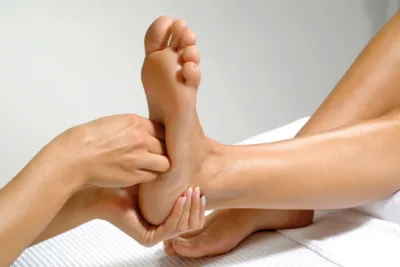Foot health is crucial for everyone, but especially for individuals with diabetes, who face unique challenges. When blood sugar levels remain high, it can damage nerves and impair foot circulation. These complications often manifest as diabetic foot pain, which not only affects quality of life but can also lead to severe complications if left untreated.
Common Causes of Diabetic Foot Pain
Diabetic foot pain rarely has a single cause—instead, it typically emerges from various diabetes-related complications. Understanding these underlying causes is crucial for developing effective treatment and prevention strategies.
- Neuropathy: Nerve damage from diabetes can cause numbness, tingling, and pain in the feet, often making it challenging to feel injuries or irritations.
- Peripheral Artery Disease (PAD): Reduced blood flow to the feet due to narrowed blood vessels can lead to pain, particularly during physical activity, and may delay healing.
- Foot Ulcers: Open sores that develop on the feet, often because of nerve damage or poor circulation, are common in individuals with diabetes and can heal slowly.
- Infection: Even minor cuts or blisters can infect people with diabetes, causing pain, swelling, redness, and, in severe cases, further complications.
Recognizing Symptoms of Diabetic Foot Pain
 Knowing the symptoms of diabetic foot pain can help you take timely action and seek treatment before problems escalate. Here are some symptoms to look out for:
Knowing the symptoms of diabetic foot pain can help you take timely action and seek treatment before problems escalate. Here are some symptoms to look out for:
- Numbness or tingling: Reduced foot sensation can lead to unnoticed injuries or infections.
- Burning or shooting pain: This type of pain, often due to neuropathy, can make walking uncomfortable and disrupt sleep.
- Sharp or throbbing pain: Common in cases of neuropathy or PAD, this pain may vary in intensity and frequency.
- Sores or ulcers: Persistent wounds that don’t heal quickly can lead to infections and severe complications if not treated.
Treatment Options for Diabetic Foot Pain
Managing diabetic foot pain requires a comprehensive approach that targets pain relief and addresses the underlying cause. Here are some effective treatment options:
- Medications: Pain relievers, specifically for neuropathy, can help control discomfort and reduce symptoms.
- Topical Treatments: Specialized creams and gels may relieve nerve pain and improve skin health.
- Physical Therapy: Targeted exercises can help improve circulation, strengthen muscles, and reduce pain, making walking easier.
- Footwear: Well-fitting shoes and custom orthotics help distribute pressure evenly across the feet, reducing pain and discomfort.
- Surgical Intervention: In severe cases, surgery may be necessary to improve blood flow or correct foot structural deformities.
Prevention Strategies for Diabetic Foot Pain
 Taking proactive steps can significantly reduce the risk of developing diabetic foot pain. Regular care and attention to your feet are key to maintaining health and preventing pain.
Taking proactive steps can significantly reduce the risk of developing diabetic foot pain. Regular care and attention to your feet are key to maintaining health and preventing pain.
- Daily Foot Inspections: Check your feet daily for cuts, blisters, redness, or signs of infection. Early detection is critical for timely intervention.
- Proper Footwear: Wear shoes that provide adequate support and cushioning, which can help prevent blisters and other injuries.
- Blood Sugar Control: Maintaining healthy blood sugar levels is essential to reduce the risk of nerve damage and circulatory issues.
- Regular Foot Care: Wash your feet daily with warm water and mild soap, and apply moisturizer to prevent dry skin and cracks that could lead to infections.
- Professional Foot Care: Schedule regular appointments with a podiatrist for specialized foot care, particularly if you have existing foot issues or are at high risk for complications.
When to See a Specialist
If you experience persistent foot pain, notice any signs of infection, or find it challenging to manage your foot health, consulting a podiatrist is crucial. Diabetic foot complications can progress quickly, and early intervention can prevent severe issues like infections, sores, or, in extreme cases, amputations.
Next Steps to Alleviate Foot Pain
By understanding the causes, symptoms, and treatment options for diabetic foot pain and by taking proactive steps to care for your feet, you can protect your mobility and enhance your quality of life. To ensure you get the specialized care you need, schedule an appointment with Celebration Foot and Ankle. Our team is here to help you manage diabetic foot pain and keep your feet healthy.


